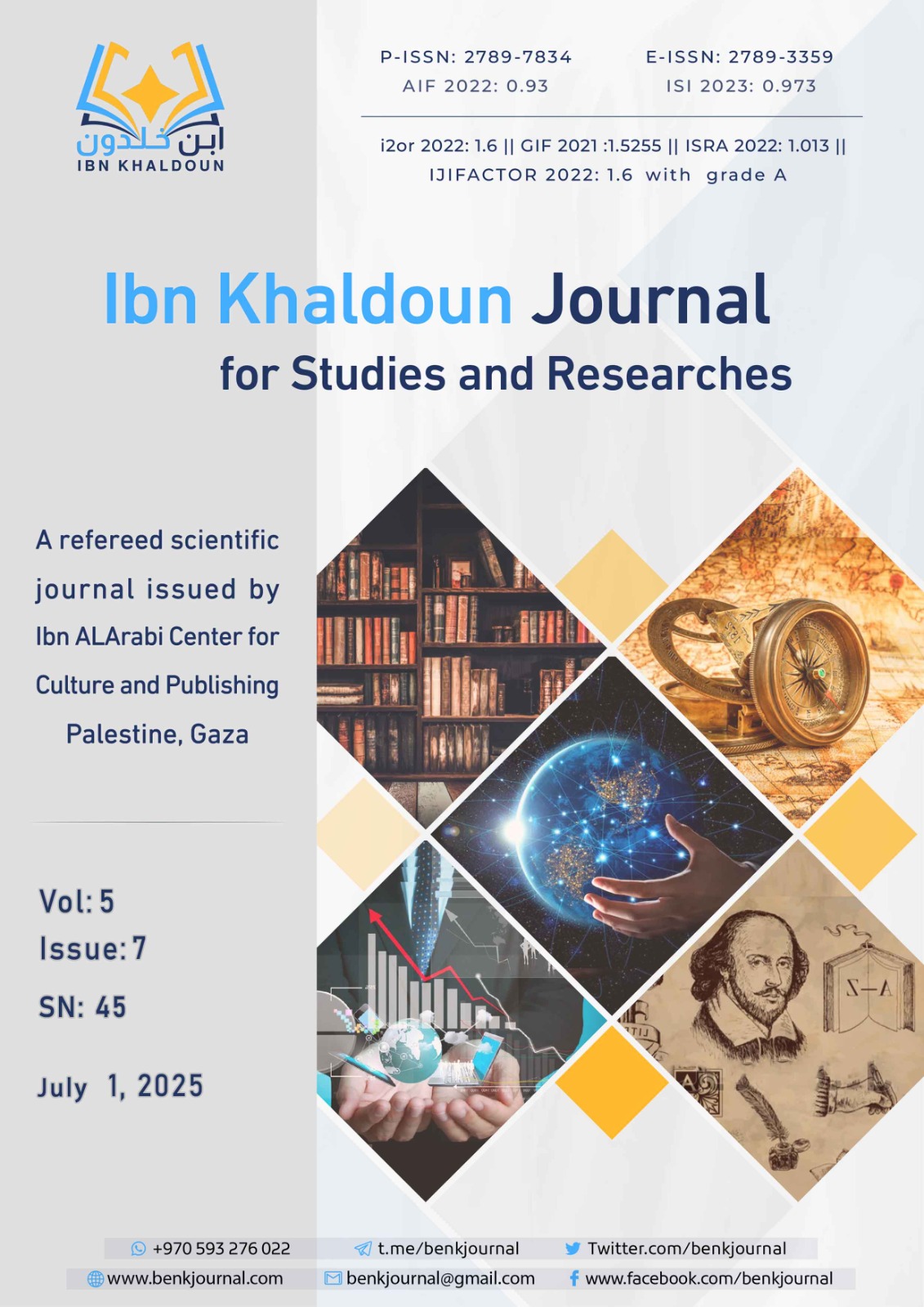Social and Cultural Structures Generating Violence Against Married Yemeni Women: Sociological Study on a Sample from the Capital Secretariat (Amanat Al-Asimah)
Main Article Content
Abstract
The study aimed to explore the social and cultural structures generating violence against married Yemeni women. To achieve this aim, the descriptive analytical approach was utilized to analyze the data and describe the phenomena both quantitatively and qualitatively, as it is the most appropriate method for such studies. Data were collected using appropriate tools, specifically a questionnaire form. The study was limited to a purposive sample of married women who have experienced violence, consisting of 81 individuals. The study reached to a set of findings, the most notable of which are: at a high level, families' reticence and reluctance to report cases of violence, weak legal awareness of women's rights and protection, and economic pressures as a factor increasing women's exposure to violence were identified as the most significant social structures contributing to violence against married Yemeni women. There has been a growth in physical violence against married women, particularly in the context of social and economic crises, followed by social pressures that compel married women to endure violence, and finally, women being exposed to verbal threats and psychological abuse, also at a high level. The study recommended fostering religious awareness among community members to reject the culture of violence against women and raising awareness of the dangers of certain harmful cultural legacies. It emphasized the marital relationship should be based on affection and mercy. Furthermore, the study called for the effective implementation and enforcement of laws protecting women from discrimination and violence, as well as the provision of legal mechanisms that ensure their protection without exposing them to any form of assault or abuse.
Metrics
Article Details

This work is licensed under a Creative Commons Attribution-NonCommercial 4.0 International License.
References
أولا: المراجع العربية.
إبراهيم، حسنين توفيق. (1992). ظاهرة العنف السياسي في النظم العربية (سلسلة أطروحات دكتوراه، 17). مركز دراسات الوحدة العربية. https://www.caus.org
ابن منظور، محمد بن مكرم. (1405هـ). لسان العرب (المجلد 9). دار أدب الحوزة.
أرندت، حنة. (1992). في العنف (إبراهيم العريس، مترجم؛ ط1). دار الساقي.
الأمم المتحدة، إدارة الشؤون الاقتصادية والاجتماعية، شعبة النهوض بالمرأة. (د. ت). [الصفحة الرئيسية للشعبة]. https://www.un.org/womenwatch/daw
البوسعيدي، خلفان بن سالم بن خلفان. (2020). أشكال العنف الممارس ضد المرأة واستراتيجيات الحد منه لدى عينة من النساء المتزوجات بولاية بركاء، عُمان. المجلة الإلكترونية الشاملة متعددة التخصصات، 27. https://www.eimj.org
تيرنر، جونثان. (1999). بناء النظرية الاجتماعية، ترجمة: محمد سعيد فرح، ط1، منشأة المعارف.
تيسير، محمد. (2025). نظرية الصراع الاجتماعي لكارل ماركس. المدونة العربية، المؤسسة العربية للعلوم ونشر الأبحاث. https://blog.ajsrp.com
حلمي، إجلال إسماعيل. (1999). العنف الأسري. دار قباء للطباعة والنشر.
دوركايم، إميل. (1893). تقسيم العمل الاجتماعي: دور البُنى الاجتماعية في تحقيق التماسك الاجتماعي.
ستروس، كلود ليفي. (1963). نظرياته في البُنى الثقافية تؤكد على العلاقة بين العناصر الثقافية وأنماط التفكير الإنساني.
الشمري، جميلة بنت عبيادة. (د. ت). مفهوم الثقافة في الفكر العربي والفكر الغربي. شبكة الألوكة. https://www.alukah.net
العواودة، أمل سالم. (2002). العنف ضد الزوجة في المجتمع الأردني: دراسة اجتماعية لعينة من الأسر في محافظة عمان (ط1). جامعة البلقاء التطبيقية.
عمر، معن خليل. (2004). مناهج علم الاجتماع (ط1). دار الشروق للنشر والتوزيع.
عودة، محمود. (د. ت). أسس علم الاجتماع. دار النهضة العربية للطباعة والنشر.
قنديل، أماني. (2008). الموسوعة العربية للمجتمع المدني. الهيئة المصرية العامة للكتاب.
كوش، دنيس. (2007). مفهوم الثقافة في العلوم الاجتماعية، ترجمة: منير السعيداني، مراجعة: الطاهر لبيب. مركز دراسات الوحدة العربية؛ المنظمة العربية للترجمة.
المبادرة النسوية الأورومتوسطية. (2020). دراسة إقليمية: العنف ضد النساء والفتيات في منطقة جنوب البحر الأبيض المتوسط. المرصد الإقليمي لمؤسسات المجتمع المدني.
الهلالي، محمد. (2009). العنف 17: نصوص مختارة (دفاتر فلسفية؛ ط1). دار توبقال.
نيروز، ماجري. (2024). القيم الاجتماعية وعلاقتها بالعنف تجاه المرأة في المجتمع الجزائري: دراسة تحليلية لبعض قضايا النزاع الأسري في محكمة المدية [رسالة ماجستير غير منشورة]. جامعة يحيى فارس المدية.
ثانيًا: المراجع الأجنبية.
Benagiano, G., Carrara, S., & Filippi, V. (2010). Social and ethical determinants of human sexuality: 2. Gender-based violence. The European Journal of Contraception & Reproductive Health Care, 15(4), 220–231. https://doi.org/10.3109/13625187.2010.499882
Hair, J. F., Jr., Black, W. C., Babin, B. J., & Anderson, R. E. (2010). Multivariate data analysis (7th ed.). Pearson Prentice Hall.
Hair, J. F., Sarstedt, M., Ringle, C. M., & Gudergan, S. P. (2019). Advanced issues in partial least squares structural equation modeling (PLS-SEM). Sage.
Malhotra, N. K. (2010). Marketing research: An applied orientation (6th ed.). Prentice Hall International.
Semahegn, A., & Mengistie, B. (2015). Domestic violence against women and associated factors in Ethiopia: A systematic review. Reproductive Health, 12, Article 78. https://doi.org/10.1186/s12978-015-0072-1
Zinyemba, K. G., & Hlongwana, K. (2020). Men’s conceptualisation of gender-based violence (GBV) directed to women in the Alexandra Township, South Africa. African Journal of Primary Health Care & Family Medicine, 12(1), a2340. https://doi.org/10.4102/phcfm.v12i1.2340





